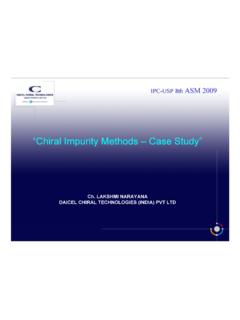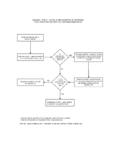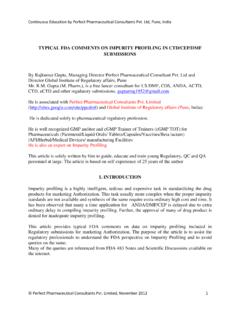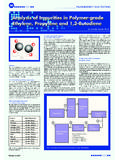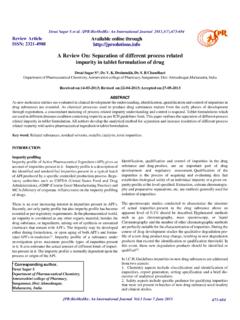Transcription of COMMITTEE FOR MEDICINAL PRODUCTS FOR …
1 European Medicines Agency Evaluation of Medicines for Human Use 7 Westferry Circus, Canary Wharf, London, E14 4HB, UK Tel. (44-20) 74 18 84 00 Fax (44-20) 74 18 86 13 E-mail: EMEA 2006 Reproduction and/or distribution of this document is authorised for non commercial purposes only provided the EMEA is acknowledged London, 28 June 2006 CPMP/SWP/5199/02 EMEA/CHMP/QWP/251344/2006 COMMITTEE FOR MEDICINAL PRODUCTS FOR HUMAN USE (CHMP) GUIDELINE ON THE LIMITS OF GENOTOXIC IMPURITIES DISCUSSION IN THE SAFETY WORKING PARTY June 2002 October 2002 TRANSMISSION TO CPMP December 2002 RELEASE FOR CONSULTATION December 2002 DEADLINE FOR COMMENTS March 2003 DISCUSSION IN THE SAFETY WORKING PARTY AND QUALITY WORKING PARTY June 2003 - February 2004 TRANSMISSION TO CPMP March 2004 RE-RELEASE FOR CONSULTATION June 2004 DEADLINE FOR COMMENTS December 2004 DISCUSSION IN THE SAFETY WORKING PARTY AND QUALITY WORKING PARTY February 2005 - May2006 ADOPTION BY CHMP 28 June 2006 DATE FOR COMING INTO EFFECT 01 January 2007 KEYWORDS Impurities; Genotoxicity.
2 Threshold of toxicological concern (TTC); Structure activity relationship (SAR) EMEA 2006 2/8 GUIDELINE ON THE LIMITS OF GENOTOXIC IMPURITIES TABLE OF CONTENTS EXECUTIVE 3 1. 3 2. 3. LEGAL 3 4. TOXICOLOGICAL 4 5. 4 Genotoxic Compounds With Sufficient Evidence for a Threshold-Related 4 Genotoxic Compounds Without Sufficient Evidence for a Threshold-Related 5 Pharmaceutical 5 Toxicological 5 Application of a Threshold of Toxicological 5 Decision Tree for Assessment of Acceptability of Genotoxic 7 8 EMEA 2006 3/8 EXECUTIVE SUMMARY The toxicological assessment of genotoxic impurities and the determination of acceptable limits for such impurities in active substances is a difficult issue and not addressed in sufficient detail in the existing ICH Q3X guidances. The data set usually available for genotoxic impurities is quite variable and is the main factor that dictates the process used for the assessment of acceptable limits.
3 In the absence of data usually needed for the application of one of the established risk assessment methods, data from carcinogenicity long-term studies or data providing evidence for a threshold mechanism of genotoxicity, implementation of a generally applicable approach as defined by the Threshold of Toxicological Concern (TTC) is proposed. A TTC value of g/day intake of a genotoxic impurity is considered to be associated with an acceptable risk (excess cancer risk of <1 in 100,000 over a lifetime) for most pharmaceuticals. From this threshold value, a permitted level in the active substance can be calculated based on the expected daily dose. Higher limits may be justified under certain conditions such as short-term exposure periods. 1. INTRODUCTION A general concept of qualification of impurities is described in the guidelines for active substances (Q3A, Impurities in New Active Substances) or MEDICINAL PRODUCTS (Q3B, Impurities in New MEDICINAL PRODUCTS ), whereby qualification is defined as the process of acquiring and evaluating data that establishes the biological safety of an individual impurity or a given impurity profile at the level(s) specified.
4 In the case of impurities with a genotoxic potential, determination of acceptable dose levels is generally considered as a particularly critical issue, which is not specifically covered by the existing guidelines. 2. SCOPE This Guideline describes a general framework and practical approaches on how to deal with genotoxic impurities in new active substances. It also relates to new applications for existing active substances, where assessment of the route of synthesis, process control and impurity profile does not provide reasonable assurance that no new or higher levels of genotoxic impurities are introduced as compared to PRODUCTS currently authorised in the EU containing the same active substance. The same also applies to variations to existing Marketing Authorisations pertaining to the synthesis. The guideline does, however, not need to be applied retrospectively to authorised PRODUCTS unless there is a specific cause for concern.
5 In the current context the classification of a compound (impurity) as genotoxic in general means that there are positive findings in established in vitro or in vivo genotoxicity tests with the main focus on DNA reactive substances that have a potential for direct DNA damage. Isolated in vitro findings may be assessed for in vivo relevance in adequate follow-up testing. In the absence of such information in vitro genotoxicants are usually considered as presumptive in vivo mutagens and carcinogens. 3. LEGAL BASIS This guideline has to be read in conjunction with Directive 2001/83/EC (as amended) and all relevant CHMP Guidance documents with special emphasis on: Impurities Testing Guideline: Impurities in New Drug Substances (CPMP/ICH/2737/99, ICHQ3A(R)) Note for Guidance on Impurities in New Drug PRODUCTS (CPMP/ICH/2738/99, ICHQ3B (R)) Note for Guidance on Impurities: Residual Solvents (CPMP/ICH/283/95) Note for Guidance on Genotoxicity: Guidance on Specific Aspects of Regulatory Genotoxicity Tests for Pharmaceuticals (CPMP/ICH/141/95, ICHS2A) Note for Guidance on Genotoxicity: A Standard Battery for Genotoxicity Testing of Pharmaceuticals (CPMP/ICH/174/95, ICHS2B) EMEA 2006 4/8 4.
6 TOXICOLOGICAL BACKGROUND According to current regulatory practice it is assumed that (in vivo) genotoxic compounds have the potential to damage DNA at any level of exposure and that such damage may lead/contribute to tumour development. Thus for genotoxic carcinogens it is prudent to assume that there is no discernible threshold and that any level of exposure carries a risk. However, the existence of mechanisms leading to biologically meaningful threshold effects is increasingly acknowledged also for genotoxic events. This holds true in particular for compounds interacting with non-DNA targets and also for potential mutagens, which are rapidly detoxified before coming into contact with critical targets. The regulatory approach to such chemicals can be based on the identification of a critical no-observed-effect level (NOEL) and use of uncertainty factors. Even for compounds which are able to react with the DNA molecule, extrapolation in a linear manner from effects in high-dose studies to very low level (human) exposure may not be justified due to several protective mechanisms operating effectively at low doses.
7 However, at present it is extremely difficult to experimentally prove the existence of threshold for the genotoxicity of a given mutagen. Thus, in the absence of appropriate evidence supporting the existence of a threshold for a genotoxic compound making it difficult to define a safe dose it is necessary to adopt a concept of a level of exposure that carries an acceptable risk. 5. RECOMMENDATIONS As stated in the Q3A guideline, actual and potential impurities most likely to arise during synthesis, purification and storage of the new drug substance should be identified, based on a sound scientific appraisal of the chemical reactions involved in the synthesis, impurities associated with raw materials that could contribute to the impurity profile of the new drug substance, and possible degradation PRODUCTS . This discussion can be limited to those impurities that might reasonably be expected based on knowledge of the chemical reactions and conditions involved.
8 Guided by existing genotoxicity data or the presence of structural alerts, potential genotoxic impurities should be identified. When a potential impurity contains structural alerts, additional genotoxicity testing of the impurity, typically in a bacterial reverse mutation assay, should be considered (Dobo et al. 2006, M ller et al. 2006). While according to the Q3A guideline such studies can usually be conducted on the drug substance containing the impurity to be controlled, studies using isolated impurities are much more appropriate for this purpose and highly recommended. For determination of acceptable levels of exposure to genotoxic carcinogens considerations of possible mechanisms of action and of the dose-response relationship are important components. Based on the above considerations genotoxic impurities may be distinguished into the following two classes: - Genotoxic compounds with sufficient (experimental) evidence for a threshold-related mechanism - Genotoxic compounds without sufficient (experimental) evidence for a threshold-related mechanism Genotoxic Compounds With Sufficient Evidence for a Threshold-Related Mechanism Examples of mechanisms of genotoxicity that may be demonstrated to lead to non-linear or thresholded dose-response relationships include interaction with the spindle apparatus of cell division leading to aneuploidy, topoisomerase inhibition, inhibition of DNA synthesis, overloading of defence mechanisms, metabolic overload and physiological perturbations ( induction of erythropoeisis, hyper- or hypothermia).
9 For (classes of) compounds with clear evidence for a thresholded genotoxicity, exposure levels which are without appreciable risk of genotoxicity can be established according to the procedure as outlined for class 2 solvents in the Q3C Note for Guidance on Impurities: Residual Solvents. This approach calculates a Permitted Daily Exposure (PDE), which is derived from the NOEL, or the lowest-observed effect level (LOEL) in the most relevant (animal) study using uncertainty factors (UF). EMEA 2006 5/8 Genotoxic Compounds Without Sufficient Evidence for a Threshold-Related Mechanism The assessment of acceptability of genotoxic impurities for which no threshold mechanisms are identified should include both pharmaceutical and toxicological evaluations. In general, pharmaceutical measurements should be guided by a policy of controlling levels to as low as reasonably practicable (ALARP principle), where avoiding is not possible.
10 Levels considered being consistent with the ALARP principle following pharmaceutical assessment should be assessed for acceptability from a toxicological point of view (see decision tree & following sections). Pharmaceutical Assessment A specific discussion as part of the overall discussion on impurities (see Q3A(R)) should be provided in the application with regard to impurities with potential genotoxicity. A rationale of the proposed formulation/manufacturing strategy should be provided based on available formulation options and technologies. The applicant should highlight, within the chemical process and impurity profile of active substance, all chemical substances, used as reagents or present as intermediates, or side- PRODUCTS , known as genotoxic and/or carcinogenic ( alkylating agents). More generally, reacting substances and substances which show alerting structure in terms of genotoxicity which are not shared with the active substance should be considered (see Dobo et al.)










